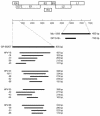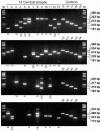Detection and typing of human papillomavirus by e6 nested multiplex PCR
- PMID: 15243079
- PMCID: PMC446280
- DOI: 10.1128/JCM.42.7.3176-3184.2004
Detection and typing of human papillomavirus by e6 nested multiplex PCR
Abstract
A nested multiplex PCR (NMPCR) assay that combines degenerate E6/E7 consensus primers and type-specific primers was evaluated for the detection and typing of human papillomavirus (HPV) genotypes 6/11, 16, 18, 31, 33, 35, 39, 42, 43, 44, 45, 51, 52, 56, 58, 59, 66, and 68 using HPV DNA-containing plasmids and cervical scrapes (n = 1,525). The performance of the NMPCR assay relative to that of conventional PCR with MY09-MY11 and GP5+-GP6+ primers, and nested PCR with these two primer sets (MY/GP) was evaluated in 495 cervical scrapes with corresponding histologic and cytologic findings. HPV prevalence rates determined with the NMPCR assay were 34.7% (102 of 294) in the absence of cervical intraepithelial neoplasia (CIN 0), 94.2% (113 of 120) in the presence of mild or moderate dysplasia (CIN I/II), and 97.8% (44 of 45) in the presence of severe dysplasia (CIN III). The combination of all four HPV detection methods applied in the study was taken as "gold standard": in all three morphological subgroups the NMPCR assay had significantly (P < 0.0001) higher sensitivities than the MY09-MY11 and GP5+-GP6+ assays and sensitivities comparable or equal to those of the MY/GP assay. All 18 HPV genotypes investigated were detected among the clinical samples. The ratio of high- to low-risk HPV genotypes increased from 4:1 (80 of 103) in CIN 0 to 19:1 (149 of 157) in CIN I to III. Multiple infections were detected in 47.9% (124 of 259) of the patients. In conclusion, the novel NMPCR method is a sensitive and useful tool for HPV DNA detection, especially when exact HPV genotyping and the identification of multiple HPV infections are required.
Figures





Similar articles
-
[Detection of high-risk human papillomavirus (HPV) E6 and E7 oncogene transcripts increases the specificity of the detection of a cervical intraepithelial neoplasia (CIN)].Verh Dtsch Ges Pathol. 2005;89:195-200. Verh Dtsch Ges Pathol. 2005. PMID: 18035691 German.
-
Development of a sensitive and specific assay combining multiplex PCR and DNA microarray primer extension to detect high-risk mucosal human papillomavirus types.J Clin Microbiol. 2006 Jun;44(6):2025-31. doi: 10.1128/JCM.02305-05. J Clin Microbiol. 2006. PMID: 16757593 Free PMC article.
-
Detection of human papillomavirus in cervical cell specimens by hybrid capture and PCR with different primers.Acta Biochim Pol. 2006;53(3):603-7. Epub 2006 Oct 1. Acta Biochim Pol. 2006. PMID: 17019439
-
Nested PCR with the PGMY09/11 and GP5(+)/6(+) primer sets improves detection of HPV DNA in cervical samples.J Virol Methods. 2004 Dec 1;122(1):87-93. doi: 10.1016/j.jviromet.2004.08.007. J Virol Methods. 2004. PMID: 15488625
-
Human Papillomavirus Genome based Detection and Typing: A Holistic Molecular Approach.Curr Mol Med. 2019;19(4):237-246. doi: 10.2174/1566524019666190405120441. Curr Mol Med. 2019. PMID: 30950352 Review.
Cited by
-
Absence of Human Papillomavirus in Benign and Malignant Breast Tissue.Iran J Pathol. 2019 Fall;14(4):279-283. doi: 10.30699/ijp.2019.89684.1847. Epub 2019 Sep 22. Iran J Pathol. 2019. PMID: 31754356 Free PMC article.
-
Global improvement in genotyping of human papillomavirus DNA: the 2011 HPV LabNet International Proficiency Study.J Clin Microbiol. 2014 Feb;52(2):449-59. doi: 10.1128/JCM.02453-13. Epub 2013 Nov 20. J Clin Microbiol. 2014. PMID: 24478473 Free PMC article.
-
Unusual prevalence of high-risk genotypes of human papillomavirus in a group of women with neoplastic lesions and cervical cancer from Central Mexico.PLoS One. 2019 Apr 18;14(4):e0215222. doi: 10.1371/journal.pone.0215222. eCollection 2019. PLoS One. 2019. PMID: 30998701 Free PMC article. Clinical Trial.
-
The small splice variant of HPV16 E6, E6, reduces tumor formation in cervical carcinoma xenografts.Virology. 2014 Feb;450-451:153-164. doi: 10.1016/j.virol.2013.12.011. Epub 2014 Jan 1. Virology. 2014. PMID: 24503078 Free PMC article.
-
Tumor evolution and intratumor heterogeneity of an oropharyngeal squamous cell carcinoma revealed by whole-genome sequencing.Neoplasia. 2013 Dec;15(12):1371-8. doi: 10.1593/neo.131400. Neoplasia. 2013. PMID: 24403859 Free PMC article.
References
-
- Baay, M. F., W. G. Quint, J. Koudstaal, H. Hollema, J. M. Duk, M. P. Burger, E. Stolz, and P. Herbrink. 1996. Comprehensive study of several general and type-specific primer pairs for detection of human papillomavirus DNA by PCR in paraffin-embedded cervical carcinomas. J. Clin. Microbiol. 34:745-747. - PMC - PubMed
-
- Bollen, L. J., A. H. Tjong, J. van der Velden, K. Brouwer, B. W. Mol, F. J. ten Kate, and J. ter Schegget. 1997. Hum. papillomavirus deoxyribonucleic acid detection in mildly or moderately dysplastic smears: a possible method for selecting patients for colposcopy. Am. J. Obstet. Gynecol. 177:548-553. - PubMed
-
- Bosch, F. X., M. M. Manos, N. Munoz, M. Sherman, A. M. Jansen, J. Peto, M. H. Schiffman, V. Moreno, R. Kurman, K. V. Shah, et al. 1995. Prevalence of human papillomavirus in cervical cancer: a worldwide perspective. J. Natl. Cancer Inst. 87:796-802. - PubMed
Publication types
MeSH terms
Substances
LinkOut - more resources
Full Text Sources
Other Literature Sources
Miscellaneous

